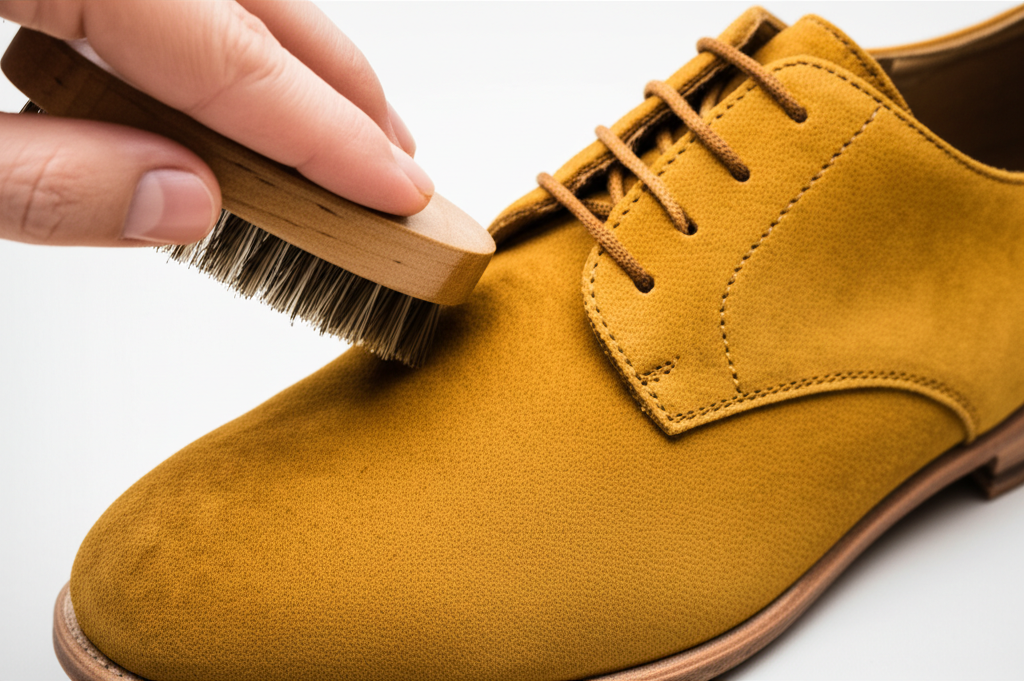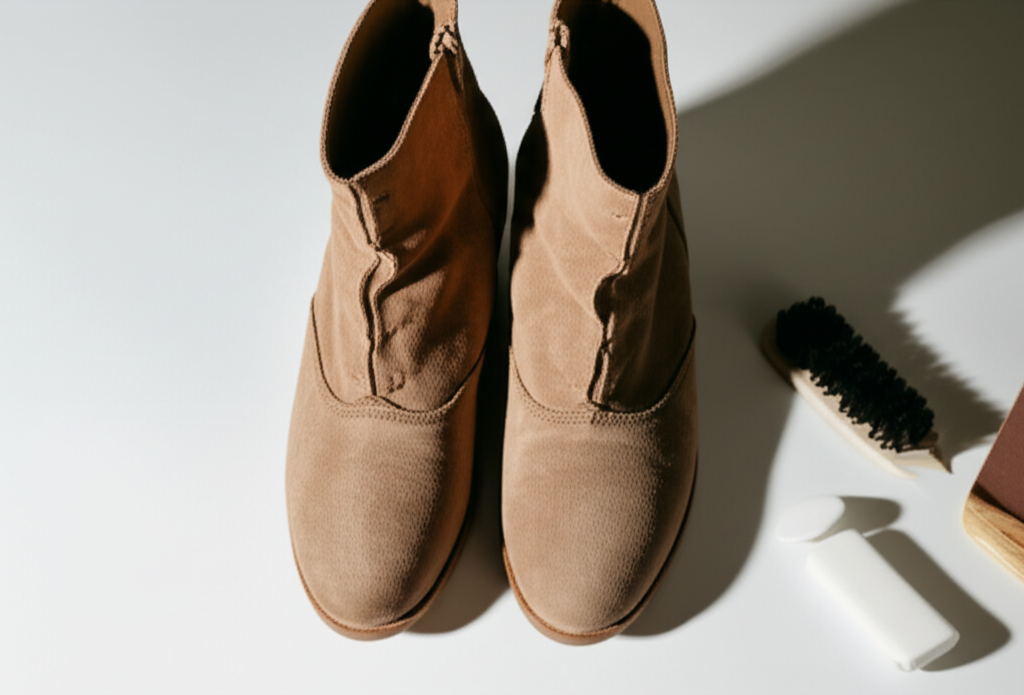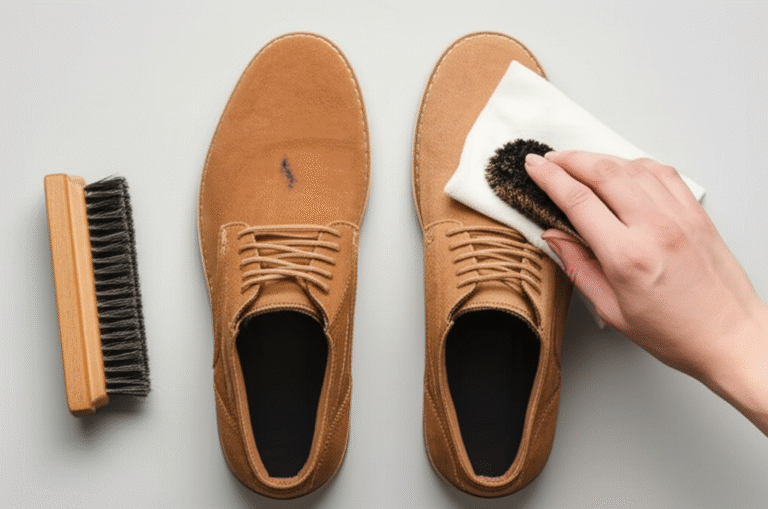What is the Best Way to Clean Suede Shoes
The best way to clean suede shoes involves gentle brushing to remove dry dirt, followed by targeted stain treatment with a suede eraser or specialized cleaner, and a final brushing to restore the nap. Always protect your suede shoes with a waterproofing spray afterward.
Key Takeaways
- Brush suede shoes regularly to prevent dirt buildup.
- Use a suede eraser for common marks and scuffs.
- Treat tough stains with a dedicated suede cleaner.
- Protect your suede with a waterproofing spray.
- Test cleaning products in an inconspicuous area first.
- Avoid getting suede shoes excessively wet.
Suede shoes are stylish and versatile, adding a touch of class to any outfit. But let’s be honest, they can also be a bit intimidating to clean. You might worry about damaging that soft, fuzzy texture or leaving water spots. It’s a common concern, and many people aren’t sure where to start. The good news is, with the right tools and a little patience, you can keep your suede shoes looking fantastic. We’ll walk you through a simple, step-by-step process that’s effective and beginner-friendly. Get ready to restore your favorite suede kicks to their former glory!
Understanding Suede: Why It Needs Special Care

Before we dive into cleaning, it’s helpful to understand what suede actually is. Suede is a type of leather that has a napped or fuzzy finish. This is achieved by buffing the inner side of the animal hide. Because of this unique texture, suede is more delicate and porous than smooth leather. This means it can absorb liquids and stains more easily and is more susceptible to damage from harsh cleaning methods. Unlike smooth leather, which has a protective topcoat, suede’s natural fibers are exposed, making it prone to marks, scuffs, and general wear and tear.
The porous nature of suede is why it’s so important to use the right cleaning products and techniques. Water can leave dark spots, and abrasive cleaners can strip away the nap, leaving the shoe looking dull and worn. Knowing this, we can approach cleaning suede with the care it deserves, ensuring we preserve its unique texture and appearance.
Essential Tools for Suede Shoe Cleaning
Having the right equipment is half the battle when it comes to cleaning suede. You don’t need a lot, and most of these items are relatively inexpensive and can be found at most shoe care stores or online. Having these on hand will make the cleaning process much smoother and more effective.
The Suede Cleaning Toolkit
- Suede Brush: This is your most important tool. A good suede brush typically has brass or nylon bristles on one side and rubber nubs or crepe on the other. The bristles are for general cleaning and lifting the nap, while the rubber side is excellent for removing dry dirt and scuffs.
- Suede Eraser (or Pencil Eraser): A specialized suede eraser is ideal for spot-cleaning dry marks, scuffs, and small stains. A clean, regular pencil eraser can work in a pinch, but be gentle.
- White Vinegar or Rubbing Alcohol: For tougher stains, particularly grease or oil, these can be used sparingly.
- Cornstarch or Talcum Powder: Excellent for absorbing fresh grease or oil stains.
- Clean Cloths: Microfiber cloths are best as they are soft and absorbent.
- Suede Protector Spray: This is crucial for preventing future stains and water damage.
- Optional: Suede Cleaner: For stubborn stains that an eraser or vinegar can’t tackle, a dedicated suede cleaner can be a lifesaver.
Investing in a quality suede brush and eraser will make a significant difference. These tools are designed specifically for the material and will help you achieve the best results without causing harm. Always ensure your tools are clean before you start cleaning your shoes.
Step-by-Step Guide: How to Clean Suede Shoes

Cleaning suede shoes doesn’t have to be complicated. By following these steps, you can tackle most common issues and keep your footwear looking fresh and new. Remember, the key is to be gentle and work methodically.
Step 1: Dry Brush Away Loose Dirt and Debris
This is the first and most crucial step for any suede cleaning. Before you even think about water or cleaners, you need to remove as much dry dirt, dust, and debris as possible. This prevents the dirt from turning into mud when you introduce moisture.
How to do it:
- Ensure your shoes are completely dry.
- Use your suede brush and gently brush the entire surface of the shoe. Brush in one direction to start, which helps lift the nap.
- For stubborn dry dirt or mud that has caked on, you can use the rubber or crepe side of your suede brush. Gently rub the affected areas.
- If you encounter any raised or matted areas of the nap, use the brass or nylon bristles of the brush to gently lift and restore the texture.
This initial brushing not only cleans the surface but also helps to revive the look of the suede by bringing the fibers back to life. It’s amazing how much difference a good dry brush can make on its own.
Step 2: Tackle Dry Stains and Scuffs with a Suede Eraser
Once the loose dirt is gone, you can address any visible marks, scuffs, or dry stains. A suede eraser is your best friend for this. It works much like a regular eraser, gently rubbing away surface imperfections.
How to do it:
- Identify the specific mark or scuff you want to remove.
- Gently rub the suede eraser back and forth over the affected area.
- Don’t scrub too hard, as this can damage the suede fibers.
- After erasing, use your suede brush to brush away any eraser residue and to restore the nap in that area.
For particularly stubborn scuffs, you might need to repeat this process a few times. If you don’t have a suede eraser, a clean, white pencil eraser can be used cautiously. However, be aware that it might not be as effective and could potentially leave marks if it’s not clean.
Step 3: Dealing with Wet Stains and Tougher Marks
Wet stains, like water spots, wine spills, or grease, require a bit more attention. The key here is to act quickly and avoid spreading the stain further.
Water Stains
Water stains can be tricky because they often leave a ring as the water dries. The best approach is to dampen the entire affected panel of the shoe slightly and evenly with a clean, damp cloth, then let it dry naturally. This helps to blend the water stain into the surrounding suede.
- Lightly dampen a clean cloth with water.
- Gently blot the entire area of the stain, working from the outside in, to avoid creating a distinct edge.
- Stuff the shoes with paper or shoe trees to help them keep their shape as they dry.
- Allow the shoes to air dry completely away from direct heat or sunlight.
- Once dry, use your suede brush to restore the nap.
Grease and Oil Stains
These are some of the most challenging stains on suede. The best method is to absorb the oil before it fully sets into the fibers.
- Blot up any excess oil immediately with a clean cloth or paper towel. Do not rub.
- Generously sprinkle cornstarch or talcum powder over the stain.
- Let it sit for several hours, or preferably overnight, to absorb the grease.
- Gently brush away the powder with your suede brush.
- If the stain persists, you may need to repeat the powder application or consider a specialized suede cleaner.
Other Tough Stains (Ink, Mud, etc.)
For stains that don’t respond to brushing or the eraser, you might need to use a mild cleaning solution. White vinegar or rubbing alcohol can be effective for many types of stains.
- Dampen a clean cloth or cotton ball with a small amount of white vinegar or rubbing alcohol.
- Gently dab the stained area. Avoid saturating the suede.
- Let the area air dry completely.
- Once dry, use your suede brush to lift the nap and blend the cleaned area.
Note: Always test any cleaning solution on an inconspicuous area of the shoe first (like the inside of the tongue or a small spot on the heel) to ensure it doesn’t cause discoloration or damage.
Step 4: Restore the Suede Nap
After cleaning, the suede might look a bit flat or matted, especially in the areas you’ve worked on. Restoring the nap gives your shoes that characteristic soft, fuzzy texture back.
How to do it:
- Use the brass or nylon bristles of your suede brush.
- Brush the entire surface of the shoe in a consistent, back-and-forth motion. This helps to lift and separate the fibers.
- Pay special attention to areas that were matted or flattened during the cleaning process.
The goal is to make the suede look uniform and plush. A well-brushed suede shoe looks significantly better and feels softer to the touch.
Step 5: Protect Your Suede Shoes
This is a vital step that many people skip, but it’s essential for maintaining your suede shoes long-term. A good protector spray creates a barrier against water, stains, and dirt.
How to do it:
- Ensure your shoes are completely clean and dry.
- Take your shoes to a well-ventilated area, preferably outdoors.
- Hold the suede protector spray can about 6-8 inches away from the shoes.
- Apply a light, even coat over the entire surface of the shoe. Avoid over-saturation.
- Let the first coat dry completely.
- Apply a second light coat for extra protection.
- Allow the shoes to dry thoroughly for at least 24 hours before wearing them.
Reapply protector spray every few weeks, especially after cleaning or if the shoes have been exposed to significant moisture. You can find effective suede protector sprays from brands like Scotchgard or Collonil. For more information on fabric protection, you can refer to resources like the Textile Institute, which discusses fabric treatments and their properties.
Special Considerations for Different Suede Types
While the general steps apply to most suede shoes, there are a few nuances depending on the type of suede and the shoe itself.
Nubuck vs. Suede
Nubuck is also a type of leather with a napped finish, but it’s made from the outer side of the hide, which is more durable than suede (made from the inner side). Nubuck fibers are shorter and finer. While cleaning methods are similar, nubuck can be slightly more resistant to stains. A suede brush and eraser are still your primary tools, but be extra gentle with nubuck as its texture is even more delicate.
Colored Suede
Lighter or brightly colored suede can be more prone to showing dirt and stains. They also have a higher risk of color transfer. Always use a white or light-colored suede brush and eraser. When using liquids like vinegar or alcohol, test them very carefully in an inconspicuous area first, as they can sometimes alter the color of the dye.
Waterproof Suede Shoes
Some modern suede shoes come with a factory-applied waterproofing treatment. While this offers good protection, it’s not invincible. You’ll still need to clean them, and reapplying a compatible waterproofing spray after cleaning is a good idea to maintain their performance. Check the manufacturer’s recommendations if available.
What NOT to Do When Cleaning Suede Shoes
Just as important as knowing what to do is knowing what to avoid. These common mistakes can permanently damage your suede shoes.
- Never use water excessively: Suede and water are not good friends. Too much water can lead to water stains, stiffening of the material, and color bleeding.
- Avoid harsh detergents or soaps: These can strip the natural oils from the suede, making it dry and brittle, and can also damage the color.
- Don’t machine wash or dry: The agitation and heat of a washing machine or dryer will ruin the shape, texture, and color of suede shoes.
- Avoid direct heat for drying: Never use a hairdryer, radiator, or direct sunlight to dry suede shoes. This can cause them to shrink, warp, or become brittle.
- Don’t use wire brushes (unless specifically designed for suede): Standard wire brushes are too abrasive and can tear the delicate suede fibers.
- Don’t store in plastic: Suede needs to breathe. Storing in plastic bags can trap moisture and lead to mold or mildew.
Sticking to these “don’ts” will significantly help in preserving the integrity and appearance of your suede footwear.
Pro Tips for Long-Term Suede Care
Maintaining suede shoes is an ongoing process, not just a one-time cleaning event. Here are some expert tips to keep your suede looking its best:
- Regular brushing is key: Make it a habit to give your suede shoes a quick brush after each wear. This removes surface dust and dirt before it can settle in.
- Stuff them when not in use: Use shoe trees or crumpled paper to help maintain the shoe’s shape and absorb moisture. Cedar shoe trees are excellent as they also help control odor.
- Rotate your footwear: Avoid wearing the same pair of suede shoes every day. Giving them a day or two to rest and air out helps them maintain their structure and prevent excessive wear.
- Address spills immediately: The faster you can treat a spill, the higher your chances of preventing a permanent stain.
- Invest in good quality products: While you can improvise, using products specifically designed for suede will yield the best and safest results.
These simple habits can make a huge difference in the lifespan and appearance of your suede shoes.
Suede Cleaning FAQs
Q1: How often should I clean my suede shoes?
You should brush your suede shoes regularly, ideally after each wear, to remove surface dust. A deeper clean, involving stain removal and protection, is needed as soon as you notice dirt buildup or stains, or periodically (e.g., once every few months) depending on how often you wear them and the conditions.
Q2: Can I use baby wipes to clean suede?
Generally, no. Baby wipes contain moisture and often chemicals that can damage suede, causing water stains or altering the color and texture.
Q3: What’s the difference between a suede brush and a regular shoe brush?
A suede brush typically has softer bristles (like brass or nylon) or rubber nubs specifically designed to lift the delicate nap of suede without damaging it. Regular shoe brushes often have stiffer bristles that are too abrasive for suede.
Q4: My suede shoes got wet. What should I do?
Blot up excess water immediately with a clean, dry cloth. Then, stuff the shoes with paper or shoe trees and let them air dry naturally away from heat. Once dry, use a suede brush to restore the nap. If water spots remain, you may need to slightly dampen the entire panel and let it dry evenly.
Q5: Can I use saddle soap on suede?
No. Saddle soap is designed for smooth leather and is too harsh for suede. It can remove the nap and leave permanent marks or discoloration.
Q6: How do I get rid of salt stains on suede in winter?
Mix equal parts white vinegar and water. Lightly dampen a cloth with the solution and gently dab the salt stains. Let the shoes air dry completely, then brush the nap to restore its texture. Always test in an inconspicuous area first.
Conclusion
Cleaning suede shoes doesn’t have to be a daunting task. By understanding the material and using the right tools and techniques, you can effectively remove dirt and stains while preserving the unique texture and beauty of your footwear. Remember to start with a gentle dry brushing, tackle stains with a suede eraser or specialized cleaners, and always finish by restoring the nap and applying a protective spray. With a little care and attention, your favorite suede shoes will stay looking stylish and fresh for seasons to come.

